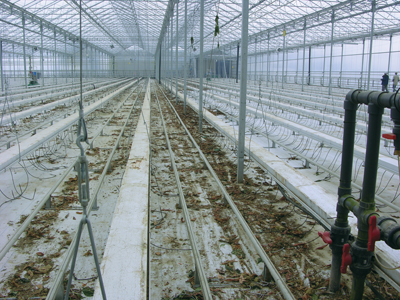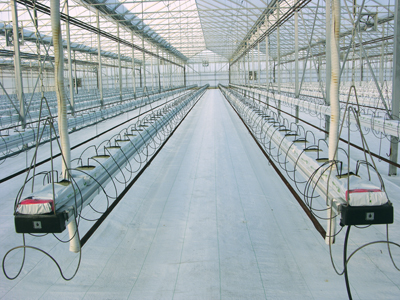
We are again at that time of year when greenhouse vegetable growers are thinking, or will soon be thinking, of cleaning up for the spring crop.
We are again at that time of year when greenhouse vegetable growers are thinking, or will soon be thinking, of cleaning up for the spring crop.
This is a tedious job, no doubt, but one which tolerates no shortcuts. Some would like to believe that subjecting the greenhouse structure and growing media to a couple of weeks of cold weather should “freeze out” pests. However, insects, mites, and disease-causing organisms have all evolved mechanisms by which they can survive the cold winters, and this basic fact makes it virtually impossible to simply freeze them out.
 |
|
| Floor covered with plant debris during cleanup.(Photos Courtesy Gillian Ferguson/OMAFRA) |
|
 |
|
| Greenhouse after thorough cleanup and disinfection. |
Many organisms are very hardy and persistent. As an example of their longevity, survival of the canker-causing bacteria on most surfaces is about one month, and can be at least 71 weeks in debris and contaminated rockwool. Other examples of very persistent disease organisms include Tobacco mosaic virus and related viruses. These viruses can survive for years in dry infected debris.
These examples illustrate the importance of removing all infected plant material and growing media, and cleaning up as best you can to minimize carryover of disease sources to the new crop.
Follow these eight steps for a good cleanup:
1. Don’t Overlap Crops – The best strategy for minimizing carry-over of pests and diseases is to have a clean break between crops. This means not having any overlap between the new crop and any part of the old one on a single operation.
Overlapping occurs when a fall crop is interplanted with transplants for the spring crop, or when spring transplants are planted while an old crop is still standing in another part of the same operation. Excluding any overlap is particularly important for breaking the cycle of persistent disease organisms, and for pests that may be disruptive to a biological control program in the established new crop.
2. Maintain Warm Temperatures – Ideally, warm temperatures (about 25ºC) during cleanup achieves better kill. Warm temperatures keep insects active which are more susceptible to insecticides. Warm temperatures also increase the effectiveness of disinfectants. In general, lower temperatures require longer contact times, whereas higher temperatures increase efficiency by two- to three-fold for every 10ºC rise in temperature.
3. Ambush Those Pests – Treatment of the crop after the last harvest but before pulling out the crop catches pests before they’ve had time to run off and hide. Such treatment also prevents the pests from going outdoors to overwinter on weeds or from entering neighbouring greenhouses.
Fogging with an effective, low-residual insecticide is one effective way of quickly killing the active stages of insects in the entire greenhouse. Systemic insecticides only affect those insects that are feeding on the plants and have no effect on those residing on weeds not on the growing media. It’s also a good idea to re-fog the warm empty greenhouse to rid the house of any residual active insects.
4. Properly Dispose of Crop Residues – There should be immediate removal and proper burial of the crop residue to prevent survival and carryover of any of the pests. Surface disking of plant residues into the soil is not sufficient. For instance, bacteria that cause Bacterial Canker can survive for at least 24 months if residues are lying on the surface. If, however, the same debris is deeply buried into the soil, survival is reduced to about seven months. When debris cannot be removed from the site or buried immediately, then it should be placed in huge bins and properly covered.
5. Disinfect Everything – Proper disinfection requires prior cleaning and washing before disinfection of the greenhouse structure and all associated equipment such as drip stakes, tools, crates, irrigation equipment, and vehicles, etc. Any debris or organic matter remaining on surfaces reacts with the disinfectant and in effect neutralizes the active ingredient of the solution.
CEMENTED AREAS REQUIRE EXTRA CARE
Of all the surfaces in a greenhouse, cemented areas require extra care. The textured surface of cement, and likely other textured surfaces, holds many kinds of organic matter and fungal/bacterial spores capable of causing disease in greenhouse plants. These areas should therefore be scrubbed or cleaned with a detergent or commercial grade cleaner and a power washer.
Note also that many disease-causing organisms are lodged on horizontal surfaces, such as on rafters, window ledges, tops of overhead piping, etc. Ideally, it is best to mix disinfectants in warm water (approx. 20ºC) and to apply the solution to dry surfaces during the evening in a warm greenhouse. Generally, contact time between disinfectant and a surface should be a minimum of 15 to 30 minutes for optimum results.
6. Keep Out Dirt – Prevent any contamination of roots of seedlings or irrigation water with dirt. Dirt is a source of countless pathogens including Pythium, Fusarium, Corky root rot, Bacterial Canker, etc. According to Dr. Bill Jarvis (retired plant pathologist, formerly at the Greenhouse and Processing Crops Research Centre, Harrow, Ont.), there can be “over 10,000 Fusarium spores per gram of dirt (a pinch).” So use of foot-baths, never placing seedlings directly on the floor, washing wheels of tractors, etc., are strongly advocated.
7. Keep Out Weeds – Remove all weeds in and around the greenhouse, clearing as large a perimeter as possible. Weeds not only harbour insect and mite pests, they are also a good reservoir for many viruses and other diseases.
8. Maintain Biosecurity/Sanitation Practices – Once the greenhouse structure is clean, ensure that all shoes and vehicle wheels, etc., are clean and disinfected before entering boiler rooms and greenhouse areas by using disinfection mats and footbaths at all entrances. Have coveralls and hand sanitizers available for all visitors.
Gillian Ferguson is the greenhouse vegetable IPM specialist with the Ontario Ministry of Agriculture, Food and Rural Affairs in Harrow, Ontario.
Gillian.ferguson@ontario.ca.
Print this page